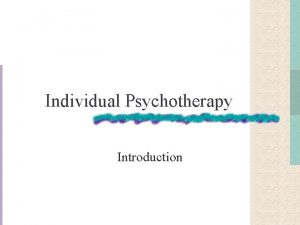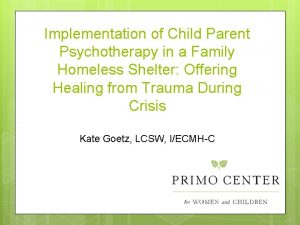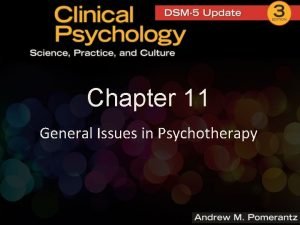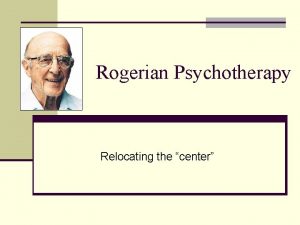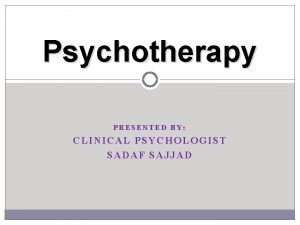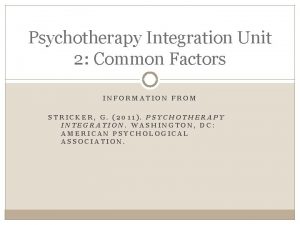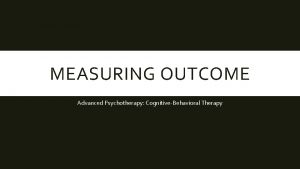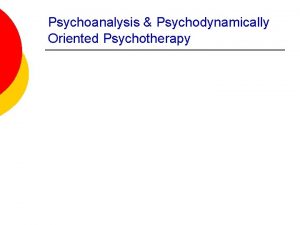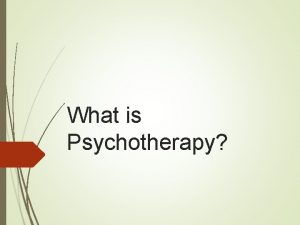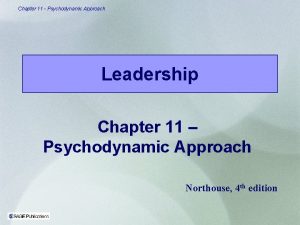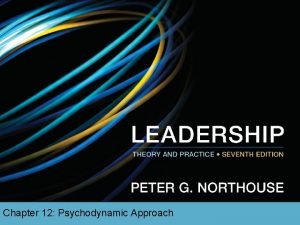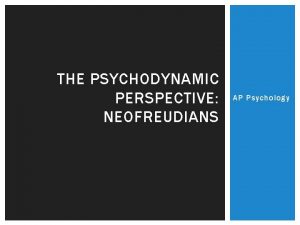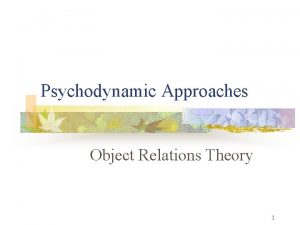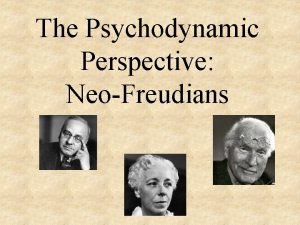Chapter 12 Psychodynamic Psychotherapy Psychodynamic Psychotherapy p p

















- Slides: 17

Chapter 12 Psychodynamic Psychotherapy

Psychodynamic Psychotherapy p p This is the first of a series of chapters on specific approaches to psychotherapy We begin with psychodynamic for numerous reasons n n n It came first historically Many otherapies were reactions against it Despite a recent decline, it still influences many clinical psychologists

Defining Psychodynamic Psychotherapy p p This textbook uses the term “psychodynamic psychotherapy” to refer broadly to Sigmund Freud’s approach to therapy and all subsequent efforts to revise and expand upon it Similar or overlapping terms include “psychoanalytic therapy” and “neo-Freudian therapy, ” among others

Goal of Psychodynamic Psychotherapy p The primary goal of psychodynamic psychotherapy is to make the unconscious n n “Insight” into thoughts, feelings, and other mental activity previously outside of awareness The very presence of the unconscious was a fundamental idea of Sigmund Freud

p Accessing the Unconscious Free Association n Clients simply say whatever comes into mind without any self-censorship or selfediting Not easy to allow self to be absolutely spontaneous Allows the unconscious to be expressed

Accessing the Unconscious (cont. ) p Freudian “slips” n p Dreams n p Verbal or behavioral “mistakes” reveal unconscious wishes Manifest content represents latent content, which contains unconscious wishes Resistance n n Clients “resist” certain topics in therapy because they touch on certain unconscious feelings or thoughts Missed appointments, tardiness, change subject

Accessing the Unconscious (cont. ) p Defense Mechanisms n Unconscious techniques created by ego, as an attempt to handle conflict between id and superego n n n Repression—keep impulse in unconscious Projection—attribute impulse to others Reaction formation—do opposite of impulse Displacement—redirect impulse Sublimation—redirect impulse in a way that benefits others

Accessing the Unconscious (cont. ) p Transference n Client forms a relationship with therapist in which client unconsciously and unrealistically expects therapist to behave like important people from the client’s past

Accessing the Unconscious (cont. ) p Transference (cont. ) n n Clients bring similar transference issues to the client-therapist relationship, just as they do to many of the other relationships in their lives Help clients become aware of their own transference tendencies and the ways in which these unrealistic perceptions of others affect their relationships and their lives n n Interpretation, followed by working through phase “Blank screen” role of therapist facilitates transference

Psychosexual Stages: Clinical Implications p Oral stage—birth to 1. 5 years old n Key issue is dependency/trust n n “Can I trust others to take care of me? ” Underindulgence distrustful and pessimistic of others Overindulgence naive and overly trusting Of course, blatantly oral behaviors can occur as well (e. g. , smoking, overeating)

Psychosexual Stages: Clinical Implications (cont. ) p Anal stage— 1. 5 to 3 years old n Key issue is control n n n Parents impose control on child (toilet training, and other forms of self-control) Overly-demanding parents “control freaks, ” obsessiveness Overly-lenient parents lax about organization, ”slobs, ” disorganization

Psychosexual Stages: Clinical Implications (cont. ) p Phallic stage— 3 to 6 years old n Key issue is self-worth/view of self Children seek to have special, close relationship with parents n If parents respond too positively, child’s sense of self becomes overinflated arrogant, egotistical n If parents respond too negatively, child’s sense of self is damaged insecure, self-doubting n

More Contemporary Forms of Psychodynamic Psychotherapy p Ego psychology n p Object relations n p Emphasizes social relationships over psychosexual stages Emphasizes relationships between internalized “objects” Self-psychology n Emphasizes parental roles in the development of the self, with special attention to narcissism

More Contemporary Forms of Psychodynamic Psychotherapy p p (cont. ) Most recent forms emphasize efficiency or brevity Brief Psychodynamic Psychotherapies n Narrow problems, quick alliance, focus on present as well as past, therapists are more active, pathology is less severe

More Contemporary Forms of Psychodynamic Psychotherapy (cont. ) p Interpersonal Therapy (IPT) n n n p Designed to treat depression in 14 -18 sessions Improving interpersonal relationships will alleviate depression Emphasis on role expectations Time-Limited Dynamic Psychotherapy (TDLP) n n Focus on transference and a therapy relationship that doesn’t follow the same unhealthy, unconscious “script” as previous relationships Make client aware of script to enable a corrective emotional experience

Outcome Issues p Very difficult to empirically measure the outcome of psychodynamic psychotherapy n n n p Improvement can’t be objectively measured Also difficult to manualize, which inhibits empirical study Regardless, large-scale reviews support its benefits with some disorders, but remains unproven with others Allegiance effects may influence outcome studies, particularly for psychodynamic therapy n n Few empirical outcome researchers are psychodynamic Researchers’ own orientations may bias the results of their studies

Outcome Issues (cont. ) p Empirical support for components of psychodynamic therapy n n Interpretation of transference reactions Interpretation of countertransference reactions
 What is difference between guidance and counselling
What is difference between guidance and counselling Ranzcp psychotherapy written case
Ranzcp psychotherapy written case Eclectic therapy psychology example
Eclectic therapy psychology example Reeducative psychotherapy
Reeducative psychotherapy Child parent psychotherapy triangle
Child parent psychotherapy triangle Introduction to psychotherapy ppt
Introduction to psychotherapy ppt Kaplan aca
Kaplan aca Dodo bird effect psychotherapy
Dodo bird effect psychotherapy General issues in psychotherapy
General issues in psychotherapy 19 propositions rogers
19 propositions rogers Psychotherapy refers to
Psychotherapy refers to Gestalt therapy examples
Gestalt therapy examples Definitions of counselling
Definitions of counselling Quantum psychotherapy
Quantum psychotherapy Imaginal disputation
Imaginal disputation The common factors approach to psychotherapy integration
The common factors approach to psychotherapy integration Padesky 5 aspects. 1986
Padesky 5 aspects. 1986 Advanced psychotherapy
Advanced psychotherapy



